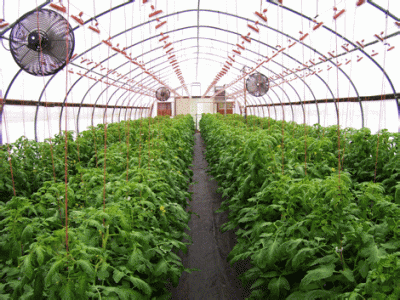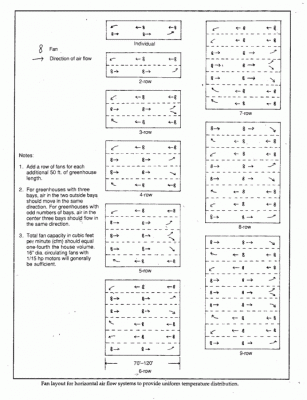Since 1967, when the Horizontal Air Flow (HAF) concept was introduced by Dr. Jay Koths, University of Connecticut Floriculture Specialist – Emeritus, it has become the standard method for air circulation in greenhouses. Over the years improvements to fan design, installation techniques and efficiency have made the system a valuable tool that helps growers produce better quality plants.
HAF is based on the principle that air moving in a coherent pattern in a building such as a greenhouse needs only enough energy to overcome turbulence and friction losses to keep it moving. In other words, it just has to be “kicked along”. The fans need to be sized correctly and placed properly to do this.
Air is heavy. The air over each square foot of floor area in a typical greenhouse weighs about one pound. A 30’ x 100’ greenhouse contains about 1.5 tons of air. Once the air is moving, it will coast along like a train. That is why HAF is so efficient. It takes only four small fans to keep it moving at 50 to 100 feet/minute (fpm) in the above greenhouse.
More uniform temperature. As the air is moved in a horizontal pattern down one side and back the other in a free-standing greenhouse or down one bay and back in an adjacent bay in a gutter-connected house, mixing occurs from side to side and floor to ceiling. We have instrumented a number of houses and seldom see more than 2 degrees F. difference between any two points. Due to the constant movement of the air, heat supplied at one end is carried to all parts of the greenhouse quickly. Stratification is also eliminated.
Less disease problems. Research has also shown that air movement of 50 to 100 fpm is adequate to keep nighttime leaf temperatures almost identical with the surrounding air. When leaf temperature is allowed to cool much below the air temperature, the dew point is reached and condensation occurs, harboring disease organisms. Radiant cooling on clear nights, especially in non-IR poly covered houses will cool plant leaves several degrees below the air temperature. HAF will reduce this difference.
Higher carbon dioxide levels. During daylight hours, photosynthesis depletes the carbon dioxide in the boundary layer of air next to the leaf. Moving air will replace this with fresh air having a higher carbon dioxide content. If supplemental carbon dioxide is added, a lower level is usually adequate to get the same plant responses for instance, 1000 ppm rather than 1200 ppm.
Cooling effect. During warm days in the spring and fall, solar radiation warms exposed leaf surfaces to as much as 15ºF above air temperature. This can cause burning of the leaves, flowers or fruit. HAF will remove this excess heat and increase plant growth.
Enhanced pesticide coverage. Most manufacturers of thermal and mechanical fogging equipment recommend the use of HAF for better distribution of spray material to leaf surfaces. The air movement created gives more uniform coverage and better penetration into the foliage.
Proper selection and installation of HAF fans is important to get good circulation and mixing of the air. The following guidelines have been grower tested and work well.
Fan capacity. To keep the air mass moving at a velocity of 50 – 100 fpm requires enough energy to overcome turbulence and friction losses. A rule of thumb based on greenhouse trials and smoke bomb tests is 2 cubic feet/minute (cfm) of fan capacity for each square foot of floor area. For example, in a 30’ x 100’ greenhouse the total cfm fan capacity needed is 6000 cfm (30’ x 100’ x 2 cfm/sq ft). This can be reduced slightly in houses with plants grown only on the floor. It may need to be increased slightly in houses with crops such as tomatoes, roses or hanging baskets. If you installed fans having 1600 cfm output, four fans would be needed (6000 cfm ÷ 1600 cfm/fan = 4 fans).
Type of fan. Circulating fans with blades that are designed to operate against zero static pressure are more efficient than exhaust fans that are designed to force air through louvers. Select fans that have a high efficiency as they normally operate 24 hours/day for 8 to 9 months of the year. Before purchasing, compare fans on an energy efficiency rating (EER), cfm output/watt of electricity input. If the manufacturer does not provide this information you can calculate it by dividing the cfm output by amps x volts. For example, a 1/15th horsepower – 16” diameter fan has an output of 1656 cfm and uses 0.9 amps @ 115 volts. EER = 1656÷(0.9 x 115) = 16 cfm/watt. Efficiencies of 14 to 16 are average. Better fans have efficiencies of 18 or higher. Generally, permanent split capacitor (PSC) motors have a higher efficiency than shaded pole motors.
Multi-speed and variable speed fans are available from some suppliers. These are considerably more expensive and cannot be justified in most applications. Low-cost residential fans have been used by some growers with good results and by others with poor results. They are generally not designed with enclosed motors for the dusty, moist conditions in a greenhouse.
Circulating fans normally push the air about 30 times their diameter. A 20” fan will move the air about 50’. Resistance from hanging baskets or tall plants will reduce airflow some. Installing fans with shrouds will extend the distance the air will be pushed. The shroud can be a sheet metal band or closely spaced wires on the fan guard in the area of the fan blades. This reduces the spread of the air stream as it leaves the blades.
To save money on the purchase of fans, some growers utilize the unit heater fans as part of the HAF system. These need to be located close to where the HAF fan would be placed and the heater fan has to be fitted with a switch to allow it to operate continuously. Although this saves on initial investment, the operating cost increases as the unit heater fan motor is usually 1/3 or ½ horsepower rather than 1/10th that is common with the HAF fan.
Fan location. Ideally the fan should be located in the center of the air mass that is being moved. In free-standing greenhouses, fans should be located ¼ of the width of the greenhouse from the sidewall. In gutter-connected greenhouses the best location is usually in the center of the bay. In both types of greenhouses, the first fan should be located 10’ – 15’ from one endwall. This boosts the air coming around the corner. Subsequent fans are usually located 30’ – 50’ apart with the last fan no closer than 50’ from the endwall. On the opposite side or adjacent bay, the same spacing holds with the first fan located 10’ – 15’ from the opposite endwall. Height of the fan is not critical but is best located above head height to get it out of the way. In many greenhouses there is a truss or collar tie that can be used for support. If the house contains hanging baskets, a location a couple of feet above or below them is best.
One problem that can occur with a poor installation is short circuiting of the air stream across the house before it reaches the next fan. This will show up as cold spots or areas of poor growth and is caused by not adding enough energy to the air or having the fans too far apart. The easiest way to check this is to use a smoke bomb available from heating system suppliers or Superior Signal Co., Inc., P.O. Box 96, Spotswood NJ 08884 – Phone: 800/945-8378. A fogger could also be used. Place the smoke or fog behind one of the fans after the air flow has stabilized. Watch its movement. Short circuiting will be easy to observe. Incense sticks also work well, especially for detecting turbulence in the air flow.
Control. Fans with 1/10th to 1/15th horsepower draw about 100 watts of electricity. Up to 15 fans can be placed on one 20 amp circuit. During the fall, winter and spring, the HAF system should run continuously. The fan circuit can be controlled by an on-off switch. A power relay could be placed in the circuit so that the HAF system is turned off if the exhaust fans are activated or vents opened. If the environment is being controlled by a controller/computer the HAF fans should be operated during heating, setpoint and low stage ventilation modes.
Cost. Standard HAF fans cost from $100 – $150 plus installation. Check with the local USDA-NRCS office to see if there is EQIP grant money available. Operating cost depends on your cost of electricity. A 100 watt fan operating 24 hours/day will use 2.4 kilowatts of electricity. At 15¢/kilowatt hour (kwh) the cost is 36¢/day.
Maintenance. Most fan motors do not require lubrication. Dust and dirt should be cleaned from the fans occasionally to increase air flow and reduce motor temperature.
John W. Bartok, Jr., Extension Professor Emeritus & Agricultural Engineer, Department of Natural Resources and the Environment, University of Connecticut, Storrs CT – Updated 2013.

